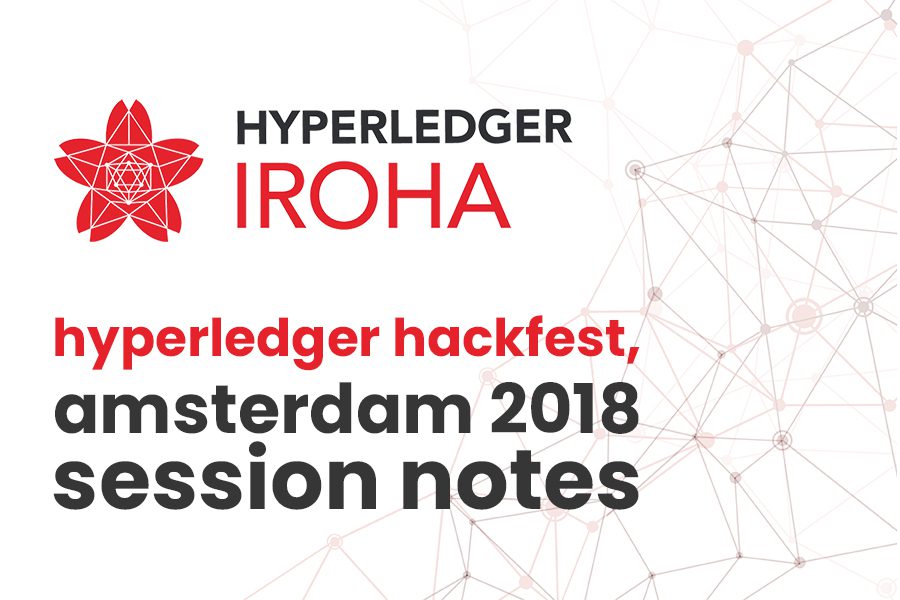Hyperledger IROHA, a Permission-Based Blockchain ProjectAmsterdam, Hyperledger Hackfest Notes (27, 28, 29 June 2018)
Hyperledger Iroha is a general purpose permissioned blockchain system that can be used to manage digital assets, identity, and serialized data. This can be useful for applications such as interbank settlement, central bank digital currencies, payment systems, national IDs, and logistics, among others.
Initially Soramitsu, IROHA, a Blockchain project developed by several leading big Japanese technology companies, including the IT giant Hitachi, has taken its place among the Hyperledger Projects.
IROHA has a “Permission Based” structure. “Distributed Ledger Technology” designed to be simple and easy to integrate in various business applications that require it. Hyperledger Iroha features a simple construction; modern, domain-driven C++ design, emphasis on mobile application development and a new, chain-based Byzantine Fault Tolerant consensus algorithm, called Sumeragi.
Key Features
- Simple deployment and maintenance
- Variety of libraries for developers
- Role-based access control
- Modular design, driven by command–query separation principle
- Assets and identity management
- Reliability (fault tolerance, recoverability)
- Performance Efficiency (in particular time-behavior and resource utilization)
- Usability (learnability, user error protection, appropriateness recognisability)
Hyperledger Hackfest Notes (Amsterdam 27, 28, 29 June 2018)
At the event of the Hyperledger Hackfest in Amsterdam, we were able to participate in the Iroha session.
The session was held by: Dumitru Savva — Soramitsu Labs.
He ran a test network and created users. Then, he transferred assets among users. In that example, we have seen that authorization is a necessity at every step. Otherwise, there is a continuous error in the operations performed on the client side. In fact, we have seen that the most important thing in Iroha is authorization as it is in other Permission-Based Blockchain systems. The algorithm is checking whether the user is authorized in every process. I am sharing screenshots of some code blocks below.
As you will see on the screen below, the admin user is equipped with permissions.
Each user has a domain ID and defined roles.
In the following functions, you can see asset transactions.
Difference Between Bitcoin and Ethereum
Bitcoin and Ethereum are designed to be permissionless ledgers where anyone can join and access all the data. They also have native cryptocurrencies that are required to interact with the systems. (BTC, ETH)
In Iroha, there is no native cryptocurrency. Instead, to meet the needs of enterprises, system interaction is permissioned, meaning that only people with requisite access can interact with the system. Additionally, queries are also permissioned, such that access to all the data can be controlled.
One major difference from Ethereum, in particular, is that Hyperledger Iroha allows users to perform common functions, such as creating and transferring digital assets, by using prebuilt commands that are in the system. This negates the need to write cumbersome and hard to test smart contracts, enabling developers to complete simple tasks faster and with less risk.
What Is The Difference Between IROHA and Other Hyperledger Projects? and Conclusion
Iroha has an algorithm called “Sumeragi” which supports “Byzantine Error Tolerance Consensus Algorithm”. It ensures high performance and low latency operations. In other Frameworks, BFT support is not yet complete. In addition, Iroha has a significant advantage over other projects in handling built-in commands. It is much simpler to complete common tasks such as creating digital assets, saving accounts, and transferring assets between accounts.
Iroha can be effective in small structures with less process intensity.
Finally, Iroha is the ledger that has a robust permission system, allowing permissions to be set for all commands, queries, and joining of the network.
